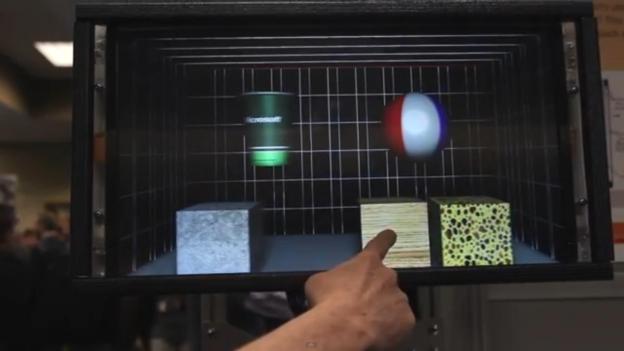
With all of the Windows 8, Xbox One, and Microsoft tablet-based news circling the Internet lately, it’s easy to forget that Microsoft also has a dedicated research sector that is always dabbling in new and innovative technologies. Today, via IEEE Spectrum, we’re getting a glimpse at one such Microsoft Research project – a robotic, moving, interactive touchscreen.
Normally, these types of projects would contain intense development cycles and the introduction of new technologies. This is a rare case though, as Microsoft Research discovered it could create its desired effect by simply snapping a display onto a robotic arm (okay, so it’s a little more technical than that).
The screen is able to sense the intensity of a user’s touch and react accordingly. In the demonstration video, shown below, principal researcher of Microsoft Research, Mike Sinclair, showcases the device’s ability to create “life like” tension by pushing on some virtual blocks. Each block is made from a different substance, and they all vary in weight. Pushing on the “metal block,” in this instance, provides much more tension than pushing on the “wooden block.” The screen moves back and forth accordingly, pushing back against Sinclair’s finger in order to simulate return force. This makes for a much more interactive touchscreen experience.
The screen is also capable of virtually mimicking the shape of an object. Sinclair shows this by pushing on the rounded edges of a beach ball. Each touch causes the screen to adjust itself forward or backward, and, according to Sinclair, the effect causes the beach ball to retain a virtual surface where it actually feels as if the ball is round, even though you are aware that you are touching a plane that is completely flat.
Microsoft has no immediate plans for the discovery, although the video does showcase how doctors could use this technology to better understand MRIs and scans. This could also prove to be a very unique tool for entertainment purposes. Microsoft already has some creative features for its Xbox with Kinect, so it’s not entirely far-fetched that the group could implement this into its gaming system somehow (although its probably unlikely we’ll see this anytime soon).
Editors' Recommendations
- The best touchscreen laptops for 2022
- Frustrated security researcher discloses Windows zero-day bug, blames Microsoft
- Microsoft warns select Windows 11 beta testers to move back to Windows 10 now
- Microsoft restores Outlook after a bizarre bug affects users for hours
- Build 2020: What to expect from Microsoft’s online-only developer conference


